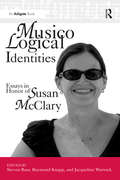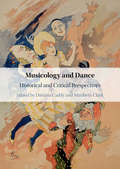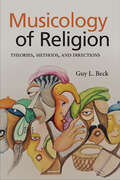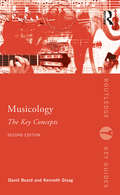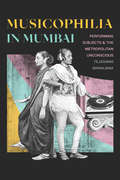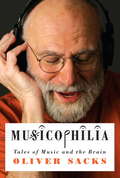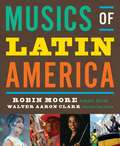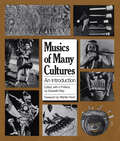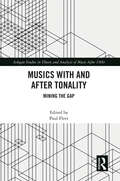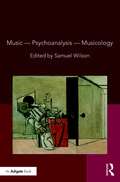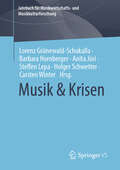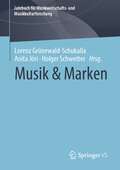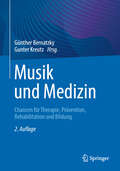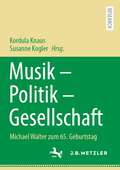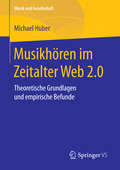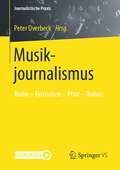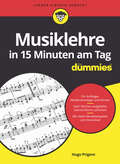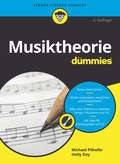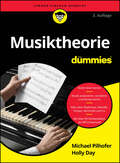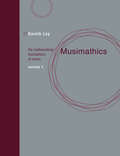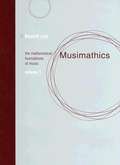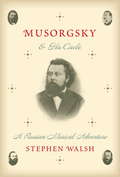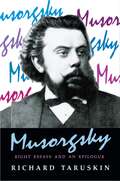- Table View
- List View
Musicological Identities: Essays in Honor of Susan McClary
by Jacqueline WarwickNo music scholar has made as profound an impact on contemporary thought as Susan McClary, a central figure in what has been termed the 'new musicology'. In this volume seventeen distinguished scholars pay tribute to her work, with essays addressing three approaches to music that have characterized her own writings: reassessing music's role in identity formation, particularly regarding gender, sexuality, and race; exploring music's capacity to define and regulate perceptions and experiences of time; and advancing new modes of analysis more appropriate to those aspects and modes of musicking ignored by traditional methods. Contributors include, in overlapping categories, many fellow pioneers, current colleagues, and former students, and their essays, like McClary's own work, address a wide range of repertories ranging from the established canon to a variety of popular genres. The collection represents the generational arrival of the 'new' musicology into full maturity, dividing fairly evenly between pre-eminent scholars of music and a group of younger scholars who have already made their mark in significant ways. But the collection is also, and fundamentally, interdisciplinary in nature, in active conversation with such fields as history, anthropology, philosophy, aesthetics, media studies, film music studies, dramatic criticism, women's studies, and cultural studies.
Musicology and Dance: Historical and Critical Perspectives
by Davinia Caddy Maribeth ClarkLong treated as peripheral to music history, dance has become prominent within musicological research, as a prime and popular subject for an increasing number of books, articles, conference papers and special symposiums. Despite this growing interest, there is a need for thorough-going critical examination of the ways in which musicologists might engage with dance, thinking not only about specific repertoires or genres, but about fundamental commonalities between the two, including embodiment, agency, subjectivity and consciousness. This volume begins to fill this gap. Ten chapters illustrate a range of conceptual, historical and interpretive approaches that advance the interdisciplinary study of music and dance. This methodological eclecticism is a defining feature, integrating insights from critical theory, cultural studies, the visual arts, phenomenology, cultural anthropology and literary criticism into the study of music and dance.
Musicology of Religion: Theories, Methods, and Directions (SUNY series in Religious Studies)
by Guy L. BeckFor generations, religion and music have been regarded as "universals," yet despite the fact that they have been frequently linked throughout history and topography, and despite the importance of music in the early stages of religious studies, their combined presence has not until now been considered a separate area of study and research. While there are well-developed fields of anthropology of religion, psychology of religion, and philosophy of religion, the widely recognized connections between religion and sound, chant, and music warrant comparable study. Drawing upon theories and methods in the study of both religion and music, referencing examples from world religious traditions, and addressing challenges posed by critics, this book envisions a unified field for religion and music: musicology of religion. Grounded in the scope and methods of phenomenology and comparative analysis, musicology of religion represents an innovative direction in interdisciplinary study, enriched by the social sciences, ethnomusicology, philosophy, theology, liturgical studies, and cognitive studies. As conceived, musicology of religion will spearhead new and creative paths in the study of religion.
Musicology: The Key Concepts (Routledge Key Guides)
by David Beard Kenneth GloagNow in an updated 2nd edition, Musicology: The Key Concepts is a handy A-Z reference guide to the terms and concepts associated with contemporary musicology. Drawing on critical theory with a focus on new musicology, this updated edition contains over 35 new entries including: Autobiography Music and Conflict Deconstruction Postcolonialism Disability Music after 9/11 Masculinity Gay Musicology Aesthetics Ethnicity Interpretation Subjectivity With all entries updated, and suggestions for further reading throughout, this text is an essential resource for all students of music, musicology, and wider performance related humanities disciplines.
Musicophilia in Mumbai: Performing Subjects and the Metropolitan Unconscious
by Tejaswini NiranjanaIn Musicophilia in Mumbai Tejaswini Niranjana traces the place of Hindustani classical music in Mumbai throughout the long twentieth century as the city moved from being a seat of British colonial power to a vibrant postcolonial metropolis. Drawing on historical archives, newspapers, oral histories, and interviews with musicians, critics, students, and instrument makers as well as her own personal experiences as a student of Hindustani classical music, Niranjana shows how the widespread love of music throughout the city created a culture of collective listening that brought together people of diverse social and linguistic backgrounds. This culture produced modern subjects Niranjana calls musicophiliacs, whose subjectivity was grounded in a social rather than an individualistic context. By attending concerts, learning instruments, and performing at home and in various urban environments, musicophiliacs embodied forms of modernity that were distinct from those found in the West. In tracing the relationship between musical practices and the formation of the social subject, Niranjana opens up new ways to think about urbanity, subjectivity, culture, and multiple modernities.
Musicophilia: Tales Of Music And The Brain (Picador Classic Ser.)
by Oliver SacksRevised and ExpandedWith the same trademark compassion and erudition he brought to The Man Who Mistook His Wife for a Hat, Oliver Sacks explores the place music occupies in the brain and how it affects the human condition. In Musicophilia, he shows us a variety of what he calls "musical misalignments." Among them: a man struck by lightning who suddenly desires to become a pianist at the age of forty-two; an entire group of children with Williams syndrome, who are hypermusical from birth; people with "amusia," to whom a symphony sounds like the clattering of pots and pans; and a man whose memory spans only seven seconds-for everything but music. Illuminating, inspiring, and utterly unforgettable, Musicophilia is Oliver Sacks' latest masterpiece.From the Trade Paperback edition.
Musics of Latin America
by Robin Moore Walter Aaaron Clark Deborah Schwartz-Kates John Koegel Cristina Magaldi Daniel Party Jonathan Ritter T. M. Scruggs Susan ThomasCovering one of the most musically diverse regions in the world, Musics of Latin America emphasizes music as a means of understanding culture and society: each author balances an analysis of musical genres with discussion of the historical and cultural trends that have shaped them. Chapters cover traditional, popular, and classical repertoire, and in-text listening guides ensure that students walk away with a solid understanding of the music.
Musics of Many Cultures: An Introduction
by Elizabeth MayThe foremost authorities in the field of music from around the world have contributed twenty original essays for this volume, edited by Elizabeth May. Only European musics have been omitted, except insofar as they affect other musics discussed here. North American music is represented by the musics of the Native Americans and the Alaskan Eskimos. The essays are profusely illustrated with maps, drawings, diagrams, photographs, and music examples. There are extensive glossaries, bibliographies, and annotated film lists. The book is directed to readers seriously interested in acquainting themselves with musics beyond the confines of Western musicology. Contributors include Bruno Nettl, Kuo-huang Han and Lindy Li Mark, Kang-sook Lee, William P. Malm, David Morton, Bonnie C. Wade, Margaret J. Kartomi, Adrienne L. Kaeppler, Trevor A. Jones, Atta Annan Mensah, John Blacking, Alfred Kwashie Ladzekpo and Kobla Ladzekpo, Cynthia Tse Kimberlin, Jozef M. Pacholczyk, Ella Zonis, Abraham A. Schwadron, David P. McAllester, Lorraine D. Koranda, and Dale A. Olsen. Please note: this book was originally published with records. The edition available now does not include the records. We are hoping to make the original recordings available in some other way.
Musics with and after Tonality: Mining the Gap (Ashgate Studies in Theory and Analysis of Music After 1900)
by Paul FleetThis volume is a journey through musics that emerged at the turn of the 20th Century and were neither exclusively tonal nor serial. They fall between these labels as they are metatonal, being both with and after tonality, in their reconstruction of external codes and gestures of Common Practice music in new and idiosyncratic ways. The composers and works considered are approached from analytic, cultural, creative, and performance angles by musicologists, performers and composers to enable a deeper reading of these musics by scholars and students alike. Works include those by Frank Bridge, Ferruccio Busoni, Mikalojus Konstantinas Čiurlionis, Rebecca Clarke, John Foulds, Percy Grainger, Mary Howe, Carl Nielsen, Franz Schreker, Erwin Schulhoff, Cyril Scott and Alexander Scriabin. In the process of engaging with this book the reader, will find an enrichment to their own understanding of music at the turn of the 20th Century.
Music—Psychoanalysis—Musicology
by Samuel WilsonThere is a growing interest in what psychoanalytic theory brings to studying and researching music. Bringing together established scholars within the field, as well as emerging voices, this collection outlines and advances psychoanalytic approaches to our understanding of a range of musics—from the romantic and the modernist to the contemporary popular. Drawing on the work of Freud, Lacan, Jung, Žižek, Barthes, and others, it demonstrates the efficacy of psychoanalytic theories in fields such as music analysis, music and culture, and musical improvisation. It engages debates about both the methods through which music is understood and the situations in which it is experienced, including those of performance and listening. This collection is an invaluable resource for students, lecturers, researchers, and anyone else interested in the intersections between music, psychoanalysis, and musicology.
Musik & Krisen (Jahrbuch für Musikwirtschafts- und Musikkulturforschung)
by Holger Schwetter Lorenz Grünewald-Schukalla Carsten Winter Anita Jóri Steffen Lepa Barbara HornbergerDie vergangenen Jahre waren für Musikkultur und Musikwirtschaft durch tiefe Krisen gekennzeichnet. Die Maßnahmen gegen die Covid-19 Pandemie griffen nicht nur tief in den Alltag der Menschen ein, sondern mit der zeitweisen Absage jeglicher Clubveranstaltungen, Festivals und dem öffentlichen Konzertwesen kam ausgerechnet jener Bereich komplett zum Erliegen, der in den Jahren davor ein starkes Wachstum verzeichnet hatte und im Tonträgermarkt wegbrechende Einnahmen kompensierte. Für viele AkteurInnen der Branche ist damit zumindest kurzfristig die gesamte Existenzgrundlage zusammengebrochen. Der vorliegende Band richtet sich an ForscherInnen wie auch PraktikerInnen aus Musikwirtschaft und Musikkultur und betrachtet das Thema aus diesem Anlass einmal ganz grundlegend. Denn Musik kann auch und gerade in Krisenzeiten vielfältige Rollen spielen: Sie kann Stellung beziehen, Trends thematisieren oder geteilten Emotionen eine Form geben. Zugleich steckt in jeder Krise ein transformatorisches Potential: Krisen beschleunigen Entwicklungen und können hierzu leider auch missbraucht werden. Der Band liefert Beiträge zu Fragen wie: Wie haben MusikkünstlerInnen auf die Corona-Situation reagiert? Wie verändern sich gegenwärtig der Musikmarkt und Musikkulturen? Welche Rolle spielt (und spielte) Musik in Transformationsprozessen, die durch Krisen ausgelöst werden?
Musik & Marken (Jahrbuch für Musikwirtschafts- und Musikkulturforschung)
by Holger Schwetter Lorenz Grünewald-Schukalla Anita JóriSpätestens seit den frühen Formationen einer auf Notendrucken basierenden Musikindustrie unterhalten musikferne Unternehmen Beziehungen zu Musik und ihren Akteur*innen. Damals wurden vornehmlich Kosmetik und Tabakprodukte in Notenbüchern beworben. Heute jedoch haben sich die Formen, bei denen Musik in den kommerziellen Aktivitäten musikferner Akteur*innen eine Rolle spielt, ausdifferenziert. Gleichzeitig hat der Markt für Aktivitäten wie Sponsoring oder Werbung an Volumen zugenommen. Hierbei spielen Marken eine besondere Rolle. Um Marken aufzubauen publizieren Unternehmen Musikmagazine, vertreiben Tonträger, organisieren und streamen Konzerte oder nehmen gar Künstler*innen mit eigenen Labels unter Vertrag. Gleichzeitig werden auch Künstler*innen und Bands durch die Musikindustrie immer stärker als Marken aufgebaut. Das Jahrbuch der GMM „Musik & Marken“ sondiert die Forschung zu Musik und Marken, versammelt empirische Befunde und zeigt neue Forschungsperspektiven in der Untersuchung von „Musik & Marken“ auf.
Musik und Fuzzy Logic: Die Dialektik von Idee und Realisierungen im Werkprozess
by Hanns-Werner HeisterDas Buch entfaltet die vielfältigen Wechselbeziehungen zwischen Fuzzy Logic und Musik in einem ersten umfassenden Überblick. Es behandelt systematisch sowohl die in diesem Zusammenhang relevanten Aspekte der Fuzzy Logic als auch die der Musik. Im Werkprozess mit drei Hauptphasen und dreizehn Existenzformen des Kunstwerks, in den Musikarten Klassik, Jazz, Pop, Folklore, zeigen sich die vier Hauptprinzipien (mit fünf Phänotypen) der Fuzzy Logic in Bezug auf die Musik: Ähnlichkeit, Schärfung I als Filterung und Schärfung II als Kristallisation, Verwischung, Variation. Ein neues Konzept ist die Dialektik zwischen Schärfung und – bewusster – "Unschärfe" durch die Verwischung. Abschließend werden Aspekte der mehrdimensionalen Dialektik in historischer Dimension entwickelt, samt einem ‚Musical Turn‘ in den Wissenschaften und Überlegungen zu einer 'Philosophie der FL'. Das produktionsorientierte Denken der Fuzzy Logic und die Musik-Analyse befruchten sich wechselseitig.
Musik und Internet: Aktuelle Phänomene populärer Kulturen (Musik und Medien)
by Peter Moormann Nicolas RuthStreaming-Plattformen und soziale Medien sind geprägt von mannigfaltigen musikalischen Formen und Inhalten. Mit ihren jeweiligen Oberflächen bzw. Gestaltungs- und Kommunikationsrahmen ermöglichen und prägen sie aktuelle Musikkulturen. Neben lang etablierten Formen, wie dem Popsong, die mehr und mehr von den Plattformlogiken und verkürzten Aufmerksamkeitsspannen strukturell beeinflusst werden, finden sich auch zahlreiche neue Phänomene, die sich aus alltäglichen Netzkulturen herausgebildet haben. Durch die unterschiedlichen Perspektiven und Phänomenaspekte des Bandes wird deutlich, wie relevant das Internet für aktuelle Musikkulturen ist und in welch komplexen Konstellationen dabei Musik gestaltet, distribuiert und rezipiert wird.
Musik und Medizin: Chancen für Therapie, Prävention, Rehabilitation und Bildung
by Günther Bernatzky Gunter KreutzDieses Buch beleuchtet die Wirkungen von Musik auf Gesundheit, Wohlbefinden und Lebensqualität aus der Sicht interdisziplinärer, musikwissenschaftlicher und medizinischer Forschung. Hochrangige Expert*innen aus vielfältigen Fachgebieten stellen die wissenschaftlichen Grundlagen für medizinische, therapeutische, pädagogische und andere Anwendung vor. Inhaltlich spannt es den Bogen von den psychophysiologischen Grundlagen emotionaler Wirkungen des Musikhörens bis hin zu musikmedizinischen und -therapeutischen Interventionen. Musik erweist sich vielfach als äußerst wirksame, nahezu nebenwirkungsfreie und vergleichsweise kostengünstige unterstützende Strategie für Prävention, Therapie und Rehabilitation in vielen medizinischen Fachbereichen.Ein breites Spektrum musikalischer Aktivitäten einschließlich Musikhören, Laienmusizieren, Chorsingen, Tanzen und verschiedene Formen musiktherapeutischer Strategien steht den Erfordernissen unterschiedlicher Zielgruppen, individuellen Unterschieden, Vorlieben und kulturellen Hintergründen gegenüber. Die Neuauflage wurde aktualisiert und mit Inhalten zu COVID 19 und einer neuen Sektion zu gesundheitlichen Belastungen durch Musik erweitert.Ärzt*innen und medizinisches Personal in Sozial- und Pflegeberufen erhalten profunde Informationen über Chancen und Grenzen musikbezogener Angebote. Die Kapitel eignen sich ebenso als Einstiege für Wissenschaftler*innen zahlreicher Fachrichtungen aus Sozial-, Natur- und Geisteswissenschaft.
Musik – Politik – Gesellschaft: Michael Walter zum 65. Geburtstag
by Kordula Knaus Susanne KoglerDer Michael Walter zum 65. Geburtstag gewidmete Band versammelt Texte renommierter Autorinnen und Autoren zum Themenbereich Musik, Politik und Gesellschaft. Dabei werden für Michael Walters Arbeiten zentrale Denkfiguren und Zugänge zur Musikgeschichte aufgegriffen und weitergedacht. Musik und Nation, höfische, bürgerliche und moderne Gesellschaften als Träger des Musiklebens, politische Brüche und Kontinuitäten, Sozial- und Institutionengeschichte der Musik, Musik als medial gebundene Aufführung und Fragen ästhetischer Wertung sind Gegenstand fundierter Quellenstudien, die aus aktuellen kultur- und geistesgeschichtlichen Perspektiven diskutiert werden.
Musikhören im Zeitalter Web 2.0
by Michael HuberIn Anschluss an aktuelle Erkenntnisse soziologischer und sozialpsychologischer Musikrezeptionsforschung erläutert der Band, welche gesellschaftlichen Funktionen das Musikhören heute erfüllt und welche Rolle hier die neuen Rahmenbedingungen im Web 2.0 spielen. Auf Basis repräsentativer empirischer Erhebungen werden musikalische Einstellungen und Verhaltensweisen illustriert sowie klar abgrenzbare Musikhörtypen charakterisiert, die in je besonderer Weise mit den aktuellen Möglichkeiten und Herausforderungen der digitalen Mediamorphose umgehen. Besondere Berücksichtigung findet dabei die Frage nach der Bedeutung primärer Sozialisation als Gegengewicht zur musikalischen Selbstsozialisation im Internet. Vor allem Alter, Schulbildung und Wohnortsgröße der Menschen zeigen sich als entscheidende Einflussgrößen der individuellen musikalischen Praxis in Österreich.
Musikjournalismus: Radio – Fernsehen – Print – Online (Journalistische Praxis)
by Peter OverbeckDieses Buch vermittelt die Grundlagen des Musikjournalismus. Erfahrene Praktiker informieren über die verschiedenen journalistischen Tätigkeiten – von der Programmgestaltung über die Musikkritik bis zur Moderation von Musiksendungen und Interviews mit Musikern in den Musiksparten von Klassik bis Pop. Die Besonderheiten in Radio, Fernsehen, Print und Online werden anhand zahlreicher Beispiele analysiert, die Funktion und der Einsatz von Musik sowie sprachliche, dramaturgische und gestalterische Mittel erörtert. Es gibt Tipps zum Berufsbild und zur Ausbildung und zu den vielfältigen Tätigkeiten.
Musiklehre in 15 Minuten am Tag für Dummies (Für Dummies)
by Hugo PrigentSie lieben Musik und würden sich gerne genauer mit Musiklehre beschäftigen? Dann ist dieses Buch genau das richtige für Sie. Egal, ob Sie schon ein Instrument spielen, damit anfangen möchten oder sich einfach nur für den theoretischen Aspekt von Musik interessieren: In übersichtlichen Lektionen erfahren Sie Woche für Woche alles Wissenswerte über Notenlesen, Akkorde und Rhythmus. Aufeinander aufbauende Übungen und die regelmäßige Wiederholung werden Ihnen helfen, in kurzer Zeit alle Grundlagen der Musiklehre zu beherrschen. Und das ganz ohne graue Theorie.
Musiktheorie für Dummies (Für Dummies)
by Michael Pilhofer Holly DayViele Musiker - ob Anfänger oder Fortgeschrittene - empfinden Musiktheorie als abschreckend und fragen sich: "Wozu das Ganze?" Die Antwort ist einfach: Schon ein wenig Grundwissen über Musiktheorie hilft Ihnen, Ihre Bandbreite als Musiker enorm zu vergrößern. Michael Pilhofer und Holly Day erklären Ihnen leicht verständlich alles Wichtige, was Sie über Musiktheorie wissen müssen - vom Lesen von Noten bis zum Komponieren eigener Songs. Sie erfahren alles über Rhythmus, Tempo, Dynamik und Co., lernen, wie Tonleitern und Akkordfolgen aufgebaut sind, wie Sie vorgehen müssen, um einer Melodie auch Harmonie zu verleihen und vieles mehr. Wenn Sie dachten, Musiktheorie sei trocken, dürfte dieses Buch eine angenehme Überraschung für Sie sein.
Musiktheorie für Dummies (Für Dummies)
by Michael Pilhofer Holly DayDa ist Musik drin! Michael Pilhofer und Holly Day erklären Ihnen in diesem Buch leicht verständlich alles Wichtige über Musiktheorie – vom Notenlesen bis zum Komponieren eigener Songs. Sie erfahren alles über Rhythmus, Tempo, Dynamik und Co., lernen, wie Tonleitern und Akkordfolgen aufgebaut sind, wie Sie einer Melodie auch Harmonie verleihen und vieles mehr. Denn schon ein wenig Grundwissen über Musiktheorie hilft Ihnen, Ihre Bandbreite als Musiker enorm zu vergrößern. Wenn Sie dachten, Musiktheorie sei trocken, wird dieses Buch eine angenehme Überraschung für Sie sein. Sie erfahren Das Wichtigste über Vorzeichen und den Quintenzirkel Das Geheimnis von Klangfarben und Akustik Was Rhythmus und Dynamik bewirken Welche Formen es in Klassik, Blues und Jazz gibt
Musimathics, Volume 1: The Mathematical Foundations of Music
by Gareth LoyA commonsense, self-contained introduction to the mathematics and physics of music; essential reading for musicians, music engineers, and anyone interested in the intersection of art and science.“Mathematics can be as effortless as humming a tune, if you know the tune,” writes Gareth Loy. In Musimathics, Loy teaches us the tune, providing a friendly and spirited tour of the mathematics of music—a commonsense, self-contained introduction for the nonspecialist reader. It is designed for musicians who find their art increasingly mediated by technology, and for anyone who is interested in the intersection of art and science.In Volume 1, Loy presents the materials of music (notes, intervals, and scales); the physical properties of music (frequency, amplitude, duration, and timbre); the perception of music and sound (how we hear); and music composition. Calling himself “a composer seduced into mathematics,” Loy provides answers to foundational questions about the mathematics of music accessibly yet rigorously. The examples given are all practical problems in music and audio.Additional material can be found at http://www.musimathics.com.
Musimathics: The Mathematical Foundations of Music, Volume 1
by Gareth LoyMathematics can be as effortless as humming a tune, if you know the tune, writes Gareth Loy. In Musimathics, Loy teaches us the tune, providing a friendly and spirited tour of the mathematics of music--a commonsense, self-contained introduction for the nonspecialist reader. It is designed for musicians who find their art increasingly mediated by technology, and for anyone who is interested in the intersection of art and science. In this volume, Loy presents the materials of music (notes, intervals, and scales); the physical properties of music (frequency, amplitude, duration, and timbre); the perception of music and sound (how we hear); and music composition. Musimathics is carefully structured so that new topics depend strictly on topics already presented, carrying the reader progressively from basic subjects to more advanced ones. Cross-references point to related topics and an extensive glossary defines commonly used terms. The book explains the mathematics and physics of music for the reader whose mathematics may not have gone beyond the early undergraduate level. Calling himself "a composer seduced into mathematics," Loy provides answers to foundational questions about the mathematics of music accessibly yet rigorously. The topics are all subjects that contemporary composers, musicians, and musical engineers have found to be important. The examples given are all practical problems in music and audio. The level of scholarship and the pedagogical approach also make Musimathics ideal for classroom use. Additional material can be found at a companion web site.
Musorgsky and His Circle
by Stephen WalshThe emergence of Russian classical music in the nineteenth century in the wake of Mikhail Glinka comprises one of the most remarkable and fascinating stories in all musical history. The five men who came together in the Russian capital of St. Petersburg in the 1860s, all composers of talent, some of genius, would be--in spite of a virtual lack of technical training--responsible for some of the greatest and best-loved music ever written. How this happened is the subject of Stephen Walsh's brilliant composite portrait of the group known in the West as the Five, and in Russia as moguchaya kuchka--the Mighty Little Heap. Friends, competitors, and creative intellectuals whose ambitions and ideas reflect the ferment of their times, Mily Balakirev, César Cui, Alexander Borodin, Nikolay Rimsky-Korsakov, and--most important of all--Modest Musorgsky, come wonderfully to life in this extended account.The detail is engrossing. We see Borodin composing music while conducting research in chemistry ("he would jump up and run back to the laboratory to make sure nothing had burnt out or boiled over there, meanwhile filling the corridor with improbable sequences of ninths or sevenths"); Balakirev tutoring Musorgsky ("Balakirev could not remedy the defects in his pupil's character, but he could confront him with works of genius"); Cui doggedly producing operas during breaks from his career as a military fortifications instructor. Musorgsky asserts his independence, moving from writing songs and the showpiece Night on Bald Mountain to the magnificent Boris Godunov, meanwhile struggling against poverty and depression. In the background such important figures as Vissarion Belinsky and Nikolay Chernïshevsky shape the cultural milieu, while the godfather of the kuchka, critic and scholar Vladimir Stasov, is seen offering sometimes combative support. As an experienced and widely skilled musical scholar and biographer (his two-volume life of Stravinsky has been called "one of the best books ever written about a musician"), Stephen Walsh is exceptionally wellplaced to tell this story. He does so with deep understanding and panache, making Musorgksy and His Circle both important and a delight to read.
Musorgsky: Eight Essays and an Epilogue
by Richard Taruskin"It is [a] fully illuminated story that Richard Taruskin, in the path-breaking essays collected here, unfolds around Modest Musorgsky, Russia's greatest national composer.... [Taruskin's] tour de force comes with a frontal attack on all the Soviet-bred truisms that for a century have refashioned Musorgsky from what the evidence suggests he was--an aristocrat with an early clinical interest in true-to-life musical portraiture and a later penchant for drinking partners who were both folklore buffs and political reactionaries democrat."--From the foreword Incorporating both new and now-classic essays, this book for the first time sets the vocal works of Modest Musorgsky in a fully detailed cultural, political, and historical context. From this perspective Richard Taruskin revises fundamentally the composer's historical and artistic image, in particular debunking the century-old dogmas of Vladimir Stasov, Musorgsky's first biographer. Here the author offers the most complete explanation of the revision of the opera Boris Godunov, compares it to contemporaneous operas by Chaikovsky and Rimsky-Korsakov, advances a revisionary characterization of Khovanshchina as an aristocratic tragedy informed by a pessimistic view of history, discusses Musorgsky's use of folklore, and, focusing on Sorochintsi Fair, brings to a climax his refutation of Musorgsky as a protorevolutionary populist. The epilogue is a survey of revisionary productions of Musorgsky's works at home during the Gorbachev era.
